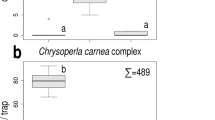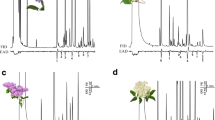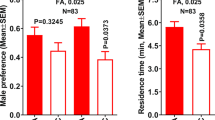Abstract
In field trapping tests, the catch of Chrysoperla carnea sensu lato (Neuroptera: Chrysopidae) increased when acetic acid was added to lures with phenylacetaldehyde. The addition of methyl salicylate to the binary mixture of phenylacetaldehyde plus acetic acid increased catches even further. The ternary blend proved to be more attractive than β-caryophyllene, 2-phenylethanol, or 3-methyl eugenol (compounds previously described as attractants for chrysopids) on their own, and no influence on catches was recorded when these compounds were added as fourth components to the ternary blend. There were minimal changes in activity when (E)-cinnamaldehyde or methyl anthranylate (both evoking large responses from female or male antennae of C. carnea in this study) were added, although both compounds showed significant attraction on their own when compared to unbaited traps. In subtractive field bioassays with the ternary mixture, it appeared that the presence of either phenylacetaldehyde or methyl salicylate was important, whereas acetic acid was less so in the ternary mixture. The ternary blend attracted both female and male lacewings at sites in southern, central, and northern Europe. Possible applications of a synthetic attractant for lacewings are discussed.




Similar content being viewed by others
References
Arn, H., Buser, H. R., Guerin, P. M., and Rauscher, S. 1986. Sex-pheromone of Eupoecilia ambiguella female—analysis and male-response to ternary blend. J. Chem. Ecol. 12:1417–1429.
Canard, M. 2001. Natural food and feeding habits of lacewings, pp. 116–129, in P. K. McEwen, T. R. New, and A. E. Whittington (eds.). Lacewings in the Crop Environment. Cambridge University Press, Cambridge, UK.
Canard, M., and Thierry, D. 2005. A historical perspective on nomenclature within the genus Chrysoperla Steinmann, 1964 in Europe: the carnea-complex (Neuroptera, Chrysopidae). Ann. Mus. civ. St. nat. Ferrara 8:173–179.
Cantelo, W. W., and Jacobson, M. 1979. Phenylacetaldehyde attracts moths to bladder flower and blacklight traps. Environ. Entomol. 8:444–447.
Casana-Giner, V., Gandia-Balaguer, A., and Primo-Yufera, E. 1999. Field trial of an attractant mixture for dipterous, including the pest Ceratitis capitata (Wiedenmann) (Dipt., Tephritidae), in Valencia, Spain. Z. Angew. Ent. 123:47–48.
Chauhan, K. R., Levi, V., Zhang, Q.-H., and Aldrich, J. R. 2007. Female goldeneyed lacewings (Neuroptera: Chrysopidae) approach but seldom enter traps baited with the male-produced compound Iridodial. J. Econ. Entomol. 100:1751–1755.
Creighton, C. S., Mcfadden, T. L., and Cuthbert, E. R. 1973. Supplementary data on phenylacetaldehyde: an attractant for Lepidoptera. J. Econ. Entomol. 66:114–115.
Dodds, C., and Mcewen, P. K. 1998. Electroantennogram responses of green lacewings (Chrysoperla carnea) to plant volatiles: preliminary results. in S. P. Panelius (ed.). Neuropterology 1997. Proceedings of the Sixth International Symposium on Neuropterology. Helsinki, Finland, 13–16 July 1997. Acta Zoologica Fennica 209:99–102.
Duelli, P. 1980. Preovipository migration flights in the green lacewing, Chrysopa carnea (Planipennia, Chrysopidae). Behav. Ecol. Sociobiol. 7:239–246.
Duelli, P. 2001. Lacewings in field crops, pp. 158–171, in P. K. McEwen, T. R. New, and A. E. Whittington (eds.). Lacewings in the Crop Environment. Cambridge University Press, Cambridge, UK.
Dunn, O. J. 1961. Multiple comparisons among means. J. Amer. Stat. Assoc. 56:52–64.
Fisher, R. A. 1966. The design of experiments. Oliver and Boyd, Edinburgh, 248 p.
Flint, H. M., Salter, S. S., and Walters, S. 1979. Caryophyllene: an attractant for the green lacewing. Environ. Entomol. 8:1123–1125.
Games, P. A., and Howell, J. F. 1976. Pairwise multiple comparison procedures with unequal n’s and/or variances: a Monte Carlo study. J. Educ. Stat. 1:113–125.
Goetz, N., Karbach, S., and Recker, H.-G. 1990. α,β-Substituted acroleins. United States Patent 4,920,232.
Henry, C. S., Brooks, S. J., Johnson, J. B., and Duelli, P. 1996. Chrysoperla lucasina (Lacroix): a distinct species of green lacewing, confirmed by acoustical analysis (Neuroptera: Chrysopidae). Syst. Entomol. 21:205–218.
Henry, C. S., Brooks, S. J., Thierry, D., Duelli, P., and Johnson, J. B. 2001. The common green lacewing (Chrysoperla carnea s. lat.) and the sibling species problem, pp. 29–42, in P. K. McEwen, T. R. New, and A. E. Whittington (eds.). Lacewings in the Crop Environment. Cambridge University Press, Cambridge, UK.
Henry, C. S., Brooks, S. J., Duelli, P., and Johnson, J. B. 2002. Discovering the true Chrysoperla carnea (Stephens) (Insecta: Neuroptera: Chrysopidae) using song analysis, morphology, and ecology. Ann. Ent. Soc. Amer. 95:172–191.
Henry, C. S., Brooks, S. J., Duelli, P., and Johnson, J. B. 2003. A lacewing with the wanderlust: the European song species ‘Maltese’, Chrysoperla agilis sp.n., of the carnea group of Chrysoperla (Neuroptera: Chrysopidae). Syst. Entomol. 28:131–148.
Hooper, A. M., Donato, B., Woodcock, C. M., Park, J. H., Pail, R. L., Boo, K. S., Hardie, J., and Pickett, J. A. 2002. Characterization of (1R,4S,4aR,7S,7aR)-dihydronepetalactol as a semiochemical for lacewings, including Chrysopa spp. and Peyerimhoffina gracilis. J. Chem. Ecol. 28:849–864.
Jaccard, J., Becker, M. A., and Wood, G. 1984. Pairwise multiple comparison procedures: a review. Psychol. Bull. 96:589–596.
James, D. G. 2003. Field evaluation of herbivore-induced plant volatiles as attractants for beneficial insects: methyl salicylate and the green lacewing, Chrysopa nigricornis. J. Chem. Ecol. 29:1601–1609.
James, D. G. 2006. Methyl salicylate is a field attractant for the goldeneyed lacewing Chrysopa oculata. Biocontrol. Sci. Technol. 16:107–110.
James, D. G., and Price, T. S. 2004. Field testing of methyl salicylate for recruitment and retention of beneficial insects in grapes and hops. J. Chem. Ecol. 30:1613–1628.
Jervis, M., and Kidd, N. (eds.). 1996. Insect Natural Enemies. Practical Approaches to Their Study and Evaluation. Chapman and Hall. London, UK.
Keiser, I. U., Jacobson, M., Nakagawa, S., Miyashita, D. H., and Harris, E. J. 1976. Mediterranean fruit fly: attraction of females to acetic acid and acetic anhydride, to two chemical intermediates in the manufacture of Cue-lure, and to decaying Hawaiian tephritids. J. Econ. Entomol. 69:517–520.
Landolt, P. J. 1998. Chemical attractants for trapping yellowjackets Vespula germanica and Vespula pensylvanica (Hymenoptera, Vespidae). Environ. Entomol. 27:1229–1234.
Landolt, P. J. 2005. Trapping the meal moth, Pyralis farinalis (Lepidoptera: Pyralidae) with acetic acid and 3-methyl-1-butanol. J. Kansas Entomol. Soc. 78:293–295.
Landolt, P. J., and Alfaro, J. F. 2001. Trapping Lacanobia subjuncta, Xestia c-nigrum, and Mamestra configurata (Lepidoptera: Noctuidae) with acetic acid and 3-methyl-1-butanol in controlled release dispensers. Environ. Entomol. 30:656–662.
Landolt, P. J., Suckling, D. M., and Judd, G. J. B. 2007. Positive interaction of a feeding attractant and a host kairomone for trapping the condling moth, Cydia pomonella (L.). J. Chem. Ecol. 33:2236–2244.
Mcewen, P. K., New, T. R., and Whittington, A. (eds.). 2001. Lacewings in the Crop Environment. Cambridge University Press, Cambridge, UK, 546 p.
Molleman, F., Drukker, B., and Blommers, L. 1997. A trap for monitoring pear psylla predators using dispensers with the synomone methylsalicylate. Proc. Exp. Appl. Entomol., N.E.V. Amsterdam 8:177–182.
Roelofs, W. L., and Cardé, R. T. 1977. Responses of Lepidoptera to synthetic sex pheromone chemicals and their analogues. Annu. Rev. Entomol. 22:377–405.
Subchev, M., Toshova, T., Tóth, M., Voigt, E., Mikulás, J., and Francke, W. 2003. Catches of vine bud moth Theresimima ampellophaga (Lep., Zygaenidae: Procridinae) males in pheromone traps: effect of the purity and age of baits, design, colour and height of the traps, and daily sexual activity of males. Z. angew. Ent. 127:1–7.
Suda, D. Y., and Cunningham, R. T. 1970. Chrysopa basalis captured in plastic traps containing methyl eugenol. J. Econ. Entomol. 63:1706.
Szentkirályi, F. 2002. Chemical ecology of lacewings, pp. 100–115, in P. K. McEwen, T. R. New, and A. E. Whittington (eds.). Lacewings in the Crop Environment. Cambridge University Press, Cambridge, UK.
Szöcs, G. 1993. Pheromone traps on the Hungarian market. Növényvédelem 29:191–193 (in Hungarian).
Thierry, D., Cloupeau, R., and Jarry, M. 1992. La chrysope commune Chrysoperla carnea (Stephens) sensu lato dans le centre de la France: mise en évidence d’un complexe d’espŹces (Insecta: Neuroptera: Chrysopidae), pp. 379–392, in M. Canard, U. Aspöck, and M. W. Mansell (eds.). Current Research in Neuropterology. Proceedings of the Fourth International Symposium on Neuropterology. Privately printed, Toulouse, France.
Thierry, D., Cloupeau, R., Jarry, M., and Canard, M. 1998. Discrimination of the West-Palaearctic Chrysoperla Steinmann species of the carnea Stephens group by means of claw morphology (Neuroptera, Chrysopidae). Acta Zool. Fenn. 209:255–262.
Tóth, M., and Szöcs, G. 1993. Pheromone studies of one and a half decade at the Plant Protection Institute. Növényvédelem 29:101–109 (in Hungarian).
Tóth, M., Imrei, Z., and Szöcs, G. 2000. Non-stcky, non-saturable, high capacity new pheromone traps for Diabrotica virgifera virgifera (Coleoptera: Chrysomelidae) and Helicoverpa (Heliothis) armigera (Lepidoptera: Noctuidae), pp. 44–49, in G. Ripka, Zs. Vendrei, Zs. Olasz, K. Spilák., and G. Kovács (eds.). Integrált Termesztés a Kertészeti és Szántóföldi Kultúrákban. BFNTÁ, Budapest (in Hungarian).
Tóth, M., Répási, V., and Szöcs, G. 2002. Chemical attractants for females of pest pyralids and phycitids (Lepidoptera: Pyralidae, Phycitidae). Acta Phytopath. Entomol. Hung. 37:375–384.
Tóth, M., Bozsik, A., Szentkirályi, F., Letardi, A., Tabilio, M. R., Verdinelli, M., Zandigiacomo, P., Jekisa, J., and Szarukán, I. 2006. Phenylacetaldehyde: a chemical attractant for common green lacewings (Chrysoperla carnea s.l., Neuroptera: Chrysopidae). Eur. J. Entomol. 103:267–271.
Tukey, J. 1949. One degree of freedom for non-additivity. Biometrics 5:232–242.
Tukey, J. 1955. Queries. Biometrics 11:111–113.
Umeya, K., and Hirao, J. 1975. Attraction of the Jackfruit fly, Dacus umbrosus F. (Diptera: Tephritidae) and lacewing, Chrysopa sp. (Neuroptera: Chrysopidae) by lure traps baited with methyl eugenol and cue-lure in the Philippines. Appl. Entomol. Zool. 10:60–62.
Utrio, P., and Eriksson, K. 1977. Volatile fermentation products as attractants for Macrolepidoptera. Ann. Zool. Fenn. 14:98–104.
Vanemden, H. F., and Hagen, K. S. 1976. Olfactory reactions of the green lacewing, Chrysopa carnea, to tryptophan and certain breakdown products. Environ. Entom. 5:469–473.
Villenave, J., Thierry, D., Al mamun, A., Lode, T., and Rat-morris, E. 2005. The pollens consumed by green lacewings Chrysoperla spp. (Neuroptera: Chrysopidae) in cabbage crop environment in western France. Eur. J. Entomol. 102:547–552.
Yothers, M. A. 1927. Summary of three years’ tests of trap baits for capturing the codling moth. J. Econ. Entomol. 20:567–575.
Zhang, Q. -H., Chauhan, K. R., Erbe, E. F., Vellore, A. R., and Aldrich, J. A. 2004. Semiochemistry of the goldeneyed lacewing Chrysopa oculata (Neuroptera: Chrysopidae): attraction of male to a male-produced pheromone. J. Chem. Ecol. 30:1849–1870.
Zhu, J. W., Cossé, A. A., Obrycki, J. J., Boo, K. S., and Baker, T. C. 1999. Olfactory reactions of the 12-spotted lady beetle, Coleomegilla maculata and the green lacewing, Chrysoperla carnea to semiochemicals released from their prey and host-plant—electroantennogram and behavioral-responses. J. Chem. Ecol. 25:1163–1177.
Zhu, J., Obrycki, J. J., Ochieng, S. A., Baker, T. C., Pickett, J. A., and Smiley, D. 2005. Attraction of two lacewing species to volatiles produced by host plants and aphid prey. Naturwissenschaften 92:277–281.
Acknowledgments
The present study was partially supported by grants from the Hungarian OTKA Foundation. Study trips of R. T. and T. M. were generously supported by the Bilateral Intergovernmental S&T Cooperation I-17/99 between Italy and Hungary.
Author information
Authors and Affiliations
Corresponding author
Rights and permissions
About this article
Cite this article
Tóth, M., Szentkirályi, F., Vuts, J. et al. Optimization of a Phenylacetaldehyde-Based Attractant for Common Green Lacewings (Chrysoperla carnea s.l.). J Chem Ecol 35, 449–458 (2009). https://doi.org/10.1007/s10886-009-9614-8
Received:
Revised:
Accepted:
Published:
Issue Date:
DOI: https://doi.org/10.1007/s10886-009-9614-8




